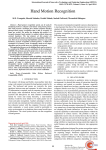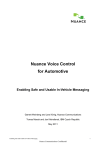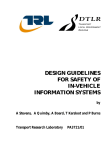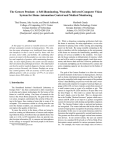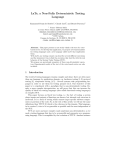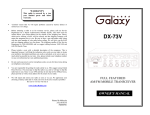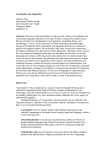Download Object-Oriented Multimodality for Safer In
Transcript
MITSUBISHI ELECTRIC RESEARCH LABORATORIES
http://www.merl.com
Object-Oriented Multimodality for Safer
In-Vehicle Interfaces
Garrett Weinberg, Bret Harsham
TR2010-084
October 2010
Abstract
Despite recent gains in the accuracy and flexibility of voice interfaces, speech-enabled in-vehicle
information systems (IVIS) still impose a significantly higher cognitive load than vehicle operation alone [6.7]. This results in degraded driving performance while carrying out common
information-retrieval (IR) tasks such as finding a particular point of interest (POI) from a navigation database or a particular song from a music library. This paper proposes a reorientation of
the IVIS interface around domain-scoped searches and contextual commands rather than around
hierarchical menus and global commands. We believe that this design will reduce IR task time
while also reducing cognitive load, thereby encouraging safer driving.
Speech in Mobile and Pervasive Environments (SiMPLE)
This work may not be copied or reproduced in whole or in part for any commercial purpose. Permission to copy in whole or in part
without payment of fee is granted for nonprofit educational and research purposes provided that all such whole or partial copies include
the following: a notice that such copying is by permission of Mitsubishi Electric Research Laboratories, Inc.; an acknowledgment of
the authors and individual contributions to the work; and all applicable portions of the copyright notice. Copying, reproduction, or
republishing for any other purpose shall require a license with payment of fee to Mitsubishi Electric Research Laboratories, Inc. All
rights reserved.
c Mitsubishi Electric Research Laboratories, Inc., 2010
Copyright 201 Broadway, Cambridge, Massachusetts 02139
MERLCoverPageSide2
Object-Oriented Multimodality for Safer In-Vehicle
Interfaces
Garrett Weinberg and Bret Harsham
Mitsubishi Electric Research Labs
201 Broadway
Cambridge, Massachusetts 02139, U.S.A.
+1.617.621.7547
{weinberg, harsham}@merl.com
ABSTRACT
Despite recent gains in the accuracy and flexibility of voice
interfaces, speech-enabled in-vehicle information systems (IVIS)
still impose a significantly higher cognitive load than vehicle
operation alone [6, 7]. This results in degraded driving
performance while carrying out common information-retrieval
(IR) tasks such as finding a particular point of interest (POI) from
a navigation database or a particular song from a music library.
This paper proposes a reorientation of the IVIS interface around
domain-scoped searches and contextual commands rather than
around hierarchical menus and global commands. We believe that
this design will reduce IR task time while also reducing cognitive
load, thereby encouraging safer driving.
Categories and Subject Descriptors
H5.2. [Information Interfaces and Presentation]: User
Interfaces – Voice I/O; Input devices and strategies (e.g., mouse,
touchscreen)
General Terms
Performance, Design, Human Factors.
Keywords
Speech recognition, voice recognition, voice search, commandand-control, object-oriented interfaces, multimodality.
1. INTRODUCTION
1.1 In-Car Voice Interfaces
Numerous advancements have been made in the last few years in
the flexibility and accuracy of automatic speech recognition
(ASR) technology for embedded (often in-vehicle) use. Nuance
and IBM have both introduced limited statistical language model
(SLM) support into their embedded recognizers, enabling
command-and-control utterances to vary significantly in their
formulation (versus earlier, strictly finite state grammar (FSG)based approaches) [10, 12]. Both Nuance and Novauris now offer
one-shot voice destination entry (VDE) technology, wherein the
house number, street, and city portions of an address may all be
included within a single utterance [10, 8]. ASR error rates on
difficult large-vocabulary recognition tasks (e.g., correctly
identifying the spoken street name when searching among all the
streets in Germany) continue to gradually improve for the ASR
engines from all major vendors.
These fundamental technical advancements, however, have not
been properly leveraged to improve the day-to-day usability of
IVIS. This is due to the fact that most IVIS have interfaces which
are built upon a hierarchy of system states. Functions are
generally divided into groups of related actions which are only
available from a particular node of the state tree. In order to
perform an action, the user must navigate around the tree to the
particular state where the action is available. This requires the
user to maintain a mental model of the system state, and the
available commands for each state.
This design leads to time-consuming stepwise interactions.
Before being able to employ the one-shot address entry
technology mentioned above, a user might first have to say
“navigation” and then, “by address.” Take for example the
currently popular voice-enabled Sync offering from Ford [5]. It
can distinguish among the spoken names of thousands of song
titles on a connected portable music player. However, unless the
system is already in portable music player mode, users must first
say “USB” before uttering a search phrase like “play track Nights
in White Satin.”
Although car entertainment systems have grown from very simple
radios with just a few modes (AM/FM) to complex computers
with tens of modes and hundreds of functions, their humanmachine interfaces (HMIs) still rely heavily on physical control
elements such as buttons and knobs. Such elements often offer
more efficient “command-and-control” than speech interfaces
because they are familiar to drivers, are not prone to errors, and
offer increased efficiency of use over time as motor memory
develops. Most importantly, however, they shorten interaction
times versus the step-by-step, hierarchical voice dialogs described
above.
1.2 Multimodality
Some IVIS ease the hierarchy traversal process by allowing one to
progress either by voice command or by manual controller
(modality equivalence in the taxonomy given in [13]). That is,
voice commands are available that equate to physical actions. For
example, in the 2009 Acura TL, a user can advance from this
vehicle’s “Search Music By” screen by either saying or manually
choosing (via the multifunction input knob) the visible menu
option for Album, Artist, Track, etc. In the Ford Sync, in addition
to saying “USB” to switch to iPod mode as explained above, one
can also press the USB button on the console (or, in certain
vehicles, cycle through input sources by repeatedly pressing the
Media button).
Though to our knowledge there have been no formal comparisons
of systems offering modality equivalence to systems that do not, it
stands to reason that the multimodal designs would improve
driving and/or visual scanning behaviors. This is because such
designs allow a user to proceed through a task using the modality
that feels most appropriate—i.e. the least temporally and
cognitively demanding—given the current traffic situation.
1.3 From Equivalence to Complementarity
Despite this presumed advantage, numerous studies have shown
that even well-designed voice and multimodal IVIS interfaces do
impose costs in terms of cognitive load, driving performance, and
visual scanning behavior ([6, 7], survey in [1]).
We contend that this is in part due to their limited application of
multimodal interaction principles. In the taxonomy cited above,
Vilimek et al. (borrowing from Martin [9]) discuss how
information from individual input modalities can be fused to
increase the throughput or decrease the ambiguity of interactions
[13]. Whereas with the modality equivalence detailed above,
“several modalities can be used to accomplish the same task,”
with modality complementarity, “the complete information of a
communicative act is distributed across several modalities.” The
combination of information from multiple modalities provides
higher throughput and thus decreases task time.
1.4 Experience from Implementation of
Modality Complementarity
We recently implemented a prototype IVIS which incorporates
modality complementarity [14].
In this prototype, it is possible to search for an item from the
user’s music collection (song, artist, or album), a Point of Interest
(POI) from the nearby area, or a person from the user’s
phonebook. The choice of which of these “domains” to search is
established by the user’s choice of a particular push-to-talk (PTT)
button among several possible PTT buttons. Each PTT button is
uniquely associated with a domain of interest. These buttons each
activate a listening tone, letting the user know she may speak her
search terms. The top results of the search are presented visually,
and a manual controller can be used to select the desired search
result.
Rather than the spoken search terms’ context being conveyed by
initial steps in a dialog—or by a carrier phrase, as in the “play
track Nights in White Satin” example above—the search terms’
context is conveyed by the tactile modality, i.e. by which of the
several PTT buttons the user has pressed. The input operation is
incomplete without the contribution of both tactile and voice
modalities; each complements the other.
This design could be thought of as an inversion of Bolt’s classic
“Put That There” interface [2], in which the referents for the
spoken deictics “that” and “there” are resolved via pointing
gestures. In our case, the put becomes a get. You tell the system
from where you want the spoken item to be retrieved by pointing
to (and pressing) a tangible representation of the kind of item it is
(a button labeled with a textual or graphical representation of that
item type).
In a usability evaluation conducted in a driving simulator, firsttime users required 40% less time to carry out IR tasks using the
multi-PTT approach than they did using the conventional, single,
state-aware PTT button. They also performed more consistently
in the task of following a lead vehicle, and reported a preference
for the multi-PTT approach for daily use in their cars. This study
is reported in [15]. One of the interesting results of this study was
that although the version of the interface offering modality
complementarity (multi-PTT) was less distracting to users in
terms of cognitive load and driving performance than the singlePTT variant, it was still measurably worse than unencumbered
driving.
2. OBJECT-ORIENTED
MULTIMODALITY (OOM)
We suggest that although modality complementarity is helpful in
reducing cognitive load, a system design based on a state tree may
be a fundamental limitation. In order to use such a system, a user
must first map the desired action to a system state, then recall how
to transition the system into the desired state, all prior to
beginning a dialog with the system. In addition, before beginning
to speak, the user must mentally model the system’s current state
and decide how to express the command or function in the
system’s currently active vocabulary.
We contend that a radical redesign of the interaction model may
be more intuitive for users. In our new model, which we call
Object-Oriented Multimodality (OOM), the user thinks of and
specifies the object first (e.g., “Thai restaurant” or “Maureen
Peterson”), and then, in a separate utterance, says what she wants
to do to that object (e.g., “go there” or “call her cell phone”).
In this model, we treat all user actions as IR tasks, where the IR
task is divided into two distinct phases. In the first phase, the user
searches for and retrieves an object to act on. This search leads to
a second, object-oriented phase, in which the object that has been
retrieved can now be used. The actions available in the second
phase depend on the kind of object that has been found (a POI, an
album, a contact from the address book, etc.).
This results in a find-then-activate interface that inverts the
thought process involved in a conventional command-and-control
interface, wherein the user must first formulate a command phrase
describing what they want to do (taking into account that some
commands might not be available in the system’s current state),
and then provide the target of the formulated command, all in one
utterance.
The following provides more details on each phase of an OOM
interaction.
2.1 Search
Current IVIS systems typically have a set of buttons that allow the
user to choose between the main areas of functionality (NAV,
PHONE, MEDIA, etc). These buttons can be overloaded for use
as “contextual” PTT buttons of the sort suggested in our prototype
implementation (by adding, for example, press-and-hold or
double-press actuation styles). The content domain is established
by which button the user chooses as a PTT in order to begin the
interaction.
In many content domains (for example POI, music, and contacts),
it makes sense to present the best matches to a spoken query in the
form of a relevance list, especially if the scores assigned by the
decoder and/or the IR engine all fall within the same narrow
range. Unless an audio-only interface is used to present this
match list1, there will necessarily be a GUI metaphor that conveys
which item within the result list is currently active, selected, or in
focus. This can be accomplished using anything from a simple
highlight box placed around a textual description of the selected
item to a revolving “carousel” of high-resolution item icons or
images, as demonstrated, for example, by Audi and nVidia at CES
2010 [3].
While the selection box or focal lens could theoretically be moved
using voice commands like “next” or “next page,” most users find
that approach clunky. Industrial designers have spent years
honing physical controls such as rocker switches and rotary dials
to make them pleasurable and effective to use for exactly this task.
Why reinvent the (mouse-)wheel?
Instead, our design encourages brief navigation within the result
list using these time-tested manual controls. If the user finds
herself scrolling through more than five or ten items, a voicebased search repetition or refinement may be warranted.
However, with a relatively unambiguous query like “Jimmy’s
Steakhouse” and proper filtering or re-scoring of results based on
such factors as proximity (in the case of POI) and
history/frequency of access (in the case of music and contacts),
the desired item is likely to appear at or near the top of the match
list the majority of the time.
2.2 Action
Once the desired item has been activated via the tactile modality,
the user issues a voice command with the focal item as this
command’s implicit referent. This is similar in spirit to Oviatt’s
map-based multimodal mock-up where users could, for example,
circle a house while saying a command like “show photo” [11].
The operand of the action (the house, in this case) is established
via manual input, while the action itself is established by spoken
input.
In our proposed system, the commands that are available in the
action phase would depend on the kind of item that was in focus.
For a POI item, these commands might include “call” and “show
on map.” An album might support the actions “play” and
“shuffle,” for example. One might be able to dispatch such
commands as “text” or “call at home” to a contact item.
SLM-based free-form command technology such as that described
above could be leveraged to allow for more “natural” contextual
commands such as “please play track three from this album” or “I
want to call her on her cell phone.” The performance of such
technology would be greatly enhanced by the absence of globallyscoped commands; we can make the engine’s job easier by
activating a small SLM that is limited to the domain of discourse
(music, POI, etc.) and designed to assume the presence a focal
item in that domain.
2.3 Further Details
While OOM as described covers the lion’s share of IVIS
functions, automotive voice user interface (VUI) experts will be
quick to point out that neither digit-based dialing nor address
entry fit neatly into the hypothetical contacts and POI search
domains we have mentioned.
1
Auditory-only presentation of long lists/menus places high
demands on working memory [16].
The former might best be addressed by employing the multifunction button paradigm introduced in [14] and [15]. The green
“call” button found on the steering wheels of many Bluetoothenabled cars generally performs a “redial” or “recent calls”
function with a single tap. When the user instead double-taps this
button, the system could issue a listening tone and accept a string
of spoken digits that will be dialed.
Address entry takes a bit more cleverness. Keeping in mind that if
POI and phonebook-based destination entry are implemented well
enough, users will seldom need to enter an address by house
number, we propose a compromise whereby street/city pairs are
included in the POI index and retrieved in the same way as
businesses. House number or intersection info can then be
provided to the retrieved pseudo-POI (a given street/city
combination) as explained above. Think of the way one tells a
taxi driver one’s destination, starting with the more granular
information and then providing the house number or intersection
later, perhaps only upon nearing the destination: “Peachtree
Street in Atlanta. Number 180.” Users should find such a design
sufficiently intuitive.
Other voice commands in a contemporary IVIS enable the
manipulation of various system settings or preferences, which,
despite their infrequency of use, inflate the size of ASR grammars
and hence decrease the accuracy of recognition. We propose
incorporating these functions en masse into their own IR domain
by indexing the human-readable description of each function from
the system’s user manual. Each indexed document corresponds to
a given setting or application state, and retrieving such a
document is equivalent to executing that command or jumping to
that application state. This “settings” IR domain would receive a
dedicated button of its own, just as the other, content-oriented
domains described above.
It should also be mentioned that while this design discourages
globally available voice commands, some vital contextual
commands such as “help” and “back” should be available no
matter what kind of item is in focus.
3. DISCUSSION AND FUTURE WORK
In the near future we plan to validate our approach by conducting
iterative prototyping and usability evaluation. While [15] offered
an initial indication that users indeed prefer to implicitly specify
search domains via their choice of button rather than by stating
the name of the domain first, in that study there were only three
active domains. This did not include the “settings” domain
proposed above, and there was no action phase required to
complete an IR task. We need to integrate these aspects into our
prototype and see if user satisfaction remains high.
In addition, there would seem to be a break-even point where the
profusion of IR domains, each with its corresponding PTT button,
results in a multimodal UI that is just as cluttered and opaque as
today’s VUIs with global commands for everything under the sun.
But whether that break-even point is four domains or fourteen
domains remains to be determined.
While switching to an OOM design alone is unlikely to result in
the ideal automotive HMI that is no more distracting or
cognitively demanding than unencumbered driving, the only way
to verify that it is indeed a step in the right direction is to
empirically evaluate driving behaviors and eye glance durations
within a simulator or a suitably instrumented vehicle. We plan to
conduct this work in the coming months.
4. REFERENCES
1.
Barón, A. and Green, P. 2006. Safety and Usability of
Speech Interfaces for In-Vehicle Tasks while Driving: A
Brief Literature Review. Technical Report UMTRI 2006-5.
Ann Arbor, MI: University of Michigan Transportation
Research Institute.
2.
Bolt, R. A. 1980. “Put-that-there”: Voice and gesture at the
graphics interface. SIGGRAPH Comput. Graph. 14, 3 (Jul.
1980), 262-270. DOI=
http://doi.acm.org/10.1145/965105.807503
3.
Cunningham, Wayne. 2010. Audi A8 handwriting
recognition hands on. CNet Australia.
http://www.cnet.com.au/audi-a8-handwriting-recognitionhands-on_p7-339300398.htm#vp. Retrieved 10 May, 2010.
4.
ETSI EG 202 191. 2003. Human Factors (HF); Multimodal
Interaction, Communication and Navigation Guidelines.
ETSI, Sophia-Antipolis Cedex, France.
http://docbox.etsi.org/EC_Files/EC_Files/eg_202191v01010
1p.pdf. Retrieved May 6, 2010.
5.
Ford Motor Company. 2010. http://www.syncmyride.com.
Retrieved 26 May, 2010.
6.
Garay-Vega, L., Pradhan, A.K., Weinberg, G., SchmidtNielsen, B., Harsham, B., Shen, Y., Divekar, G., Romoser,
M., Knodler, M., Fisher, D.L. 2010. Evaluation of Different
Speech and Touch Interfaces to In-Vehicle Music Retrieval
Systems. Accident Analysis & Prevention, 42, 3 (May 2010),
913-920.
7.
Graf, S., Spiessl, W., Schmidt, A., Winter, A., and Rigoll, G.
2008. In-car interaction using search-based user interfaces.
In Proceedings of the Twenty-Sixth Annual SIGCHI
Conference on Human Factors in Computing Systems
(Florence, Italy, April 05 - 10, 2008). CHI '08. ACM, New
York, NY, 1685-1688. DOI=
http://doi.acm.org/10.1145/1357054.1357317
8.
Hunt, M. and Kim, Y. 2006. Phonetic Techniques for
Achieving High Accuracy in Spoken Access to Very Large
Lists. In Proceedings of 2006 AVIOS Speech Technology
Symposium. New York: Applied Voice Input Output Society.
9.
Martin, J.-C. 1998. Types of Cooperation and Referenceable
Objects: Implications on Annotation Schemas for
Multimodal Language Resources. In LREC 2000 preconference workshop, Athens, Greece.
10. Nuance Communications, Inc. 2008. Nuance Introduces
Natural Language Speech Suite for Navigation &
Automotive Vendors.
http://www.nuance.co.uk/news/20080305_suite.asp.
Retrieved 25 May, 2010.
11. Oviatt, S., DeAngeli, A., and Kuhn, K. 1997. Integration and
synchronization of input modes during multimodal humancomputer interaction. In Proceedings of the SIGCHI
Conference on Human Factors in Computing
Systems (Atlanta, Georgia, United States, March 22 - 27,
1997). S. Pemberton, Ed. CHI '97. ACM, New York, NY,
415-422. DOI= http://doi.acm.org/10.1145/258549.258821.
12. Sicconi, R., White, K. D., Ruback, H., Viswanathan, M.,
Eckhart, J., Badt, D., Morita, M., Satomura, M., Nagashima,
N., Kondo, K. 2009. Honda Next Generation Speech User
Interface. SAE World Congress & Exhibition, April 2009.
13. Vilimek, R., Hempel, T., and Otto, B. 2007. Multimodal
interfaces for in-vehicle applications. In Proceedings of the
12th International Conference on Human-Computer
Interaction: Intelligent Multimodal Interaction Environments
(Beijing, China, July 22 - 27, 2007). J. A. Jacko, Ed. Lecture
Notes in Computer Science. Springer-Verlag, Berlin,
Heidelberg, 216-224.
14. Weinberg, G. 2009. Contextual push-to-talk: a new
technique for reducing voice dialog duration. In Proceedings
of the 11th International Conference on Human-Computer
interaction with Mobile Devices and Services (Bonn,
Germany, September 15 - 18, 2009). MobileHCI '09. ACM,
New York, NY, 1-2. DOI=
http://doi.acm.org/10.1145/1613858.1613960
15. Weinberg, G. and Harsham, B. 2010. Contextual push-totalk: shortening voice dialogs to improve driving
performance. In Proceedings of the 12th International
Conference on Human-Computer interaction with Mobile
Devices and Services (Lisbon, Portugal, September 7 - 10,
2010). MobileHCI '10. ACM, New York, NY.
16. Wickens, C. D., Sandry, D. and Vidulich, M. 1983.
Compatibility and resource competition between modalities
of input, central processing, and output. Human Factors, 25,
227-248.







